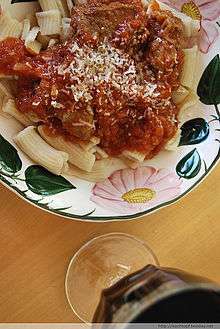Neapolitan ragù
 | |
| Type | Ragù |
|---|---|
| Place of origin | Italy |
| Region or state | Naples |
| Main ingredients | Soffritto (onion, celery, carrot), meat, tomato sauce, red wine, basil, lard or olive oil |
|
| |
Neapolitan ragù (ragù napoletano [raˈɡu nnapoleˈtaːno] or ragù alla napoletana [raˈɡu alla napoleˈtaːna] in Italian), is one of the two most famous varieties of meat sauces called ragù. It is a speciality of Naples, as its name indicates. (The other variety originated in Bologna and is known in Italian as ragù bolognese or ragù alla bolognese.)
The Neapolitan type is made from three main parts: a soffritto, meat, and tomato sauce. However, a major difference is how the meat is used, as well as the amount of tomato in the sauce. Bolognese versions use very finely chopped meat, while Neapolitan versions use whole meat, taking it from the casserole when cooked and serving it as a second course or with pasta. Also, the Neapolitan soffritto contains much more onion compared to the Bolognese. Preferences for ingredients also differ. In Naples, white wine is replaced by red wine, butter by lard or olive oil, and lots of basil leaves are used where Bolognese ragù has no herbs. In the Neapolitan recipe, the content may well be enriched by adding raisins, pine nuts, and involtini with different fillings. Milk or cream is not used, and a relative abundance of tomato sauce in flavour, in contrast to Bolognese use of a minimal amount, is preferred. The tomato season is, of course, much longer in more southern Naples than in more northern Bologna. Like the Bolognese, Neapolitan ragù also has quite a wide range of variants, the best known of which is ragù guardaporta (doorman's ragù).
Neapolitan ragù is very similar to and may be ancestral to the Italian-American "Sunday gravy", the primary difference being the addition of a greater variety of meat in the American version, most famously meatballs (whence spaghetti and meatballs), braciole, sausage, and pork chops. There is great variety in the Sunday meat sauce that is passed down from generation to generation in Italian-American families. Some families brown the meatballs and other meat cuts before putting them into the sauce, others do not. Some add red wine, others do not.[1]
